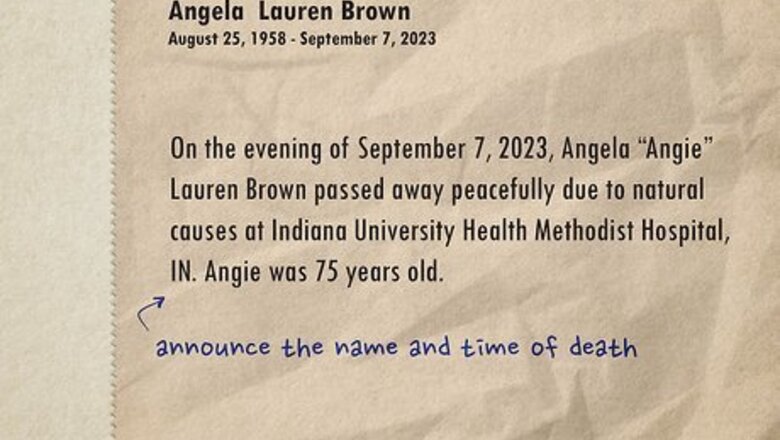
views
Structuring
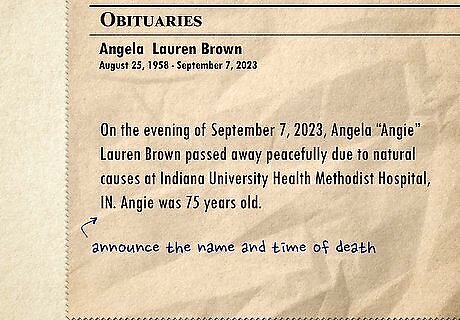
Announce the name and time of death in the first sentence. In your opening sentence, start with their name, where they lived, and when they passed away. You don’t need to provide the cause of death if you don’t want to. Keep this sentence brief and to the point so you can expand the obituary in other places. Some examples include: “On the morning of June 10, 2019, John William Smith of Atlanta died at the age of 80.” “On the evening of September 7, 2010, Angela “Angie” Lauren Brown passed away peacefully due to natural causes at Indiana University Health Methodist Hospital, IN. Angie was 75 years old.” “In the early morning of December 15, 2018, Joseph Mathew Lee passed away after a four-year battle with cancer while being tended to by staff at Northeastern Vermont Regional Hospital, VT. He was 50 years old.”
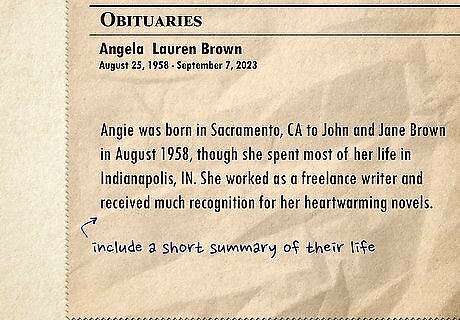
Include a short summary of their life in the next paragraph. List the city where your loved one was born, their parents, and important events that happened in their life. List these events chronologically or put them in order of what you feel is the most important. Make the obituary as concise as possible by keeping this section brief. For example: “John was born to Tom and Jill Smith in 1950. He received his bachelor’s degree in 1976 and managed John’s Restaurant in Atlanta for 22 years. In July 1980, he married Jane Doe, and together raised two children, Anna and Benjamin.” “Angie was born in Sacramento, CA to John and Jane Brown in February 1935, though she spent most of her life in Indianapolis, IN. She worked as a freelance writer and received much recognition for her heartwarming novels.” “Joseph was born in 1968 to Harry and Linda Lee in Burlington. He earned his Master’s in Education and taught high school English for nearly 30 years. He met his wife, Sarah, while working towards his degree, and they married in September 1995.
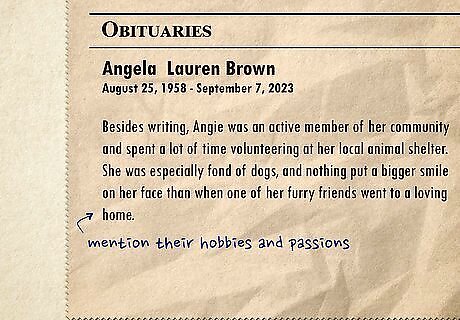
Add a short paragraph about hobbies, passions, or personal characteristics. Including personal details will capture the spirit of your loved one so others understand what their life was like and what kind of person they were. Create a list of hobbies or activities they actively participated in, and use some good adjectives to help paint a picture of their character. For example: “John was an avid car collector in his spare time. When he wasn’t working at his restaurant, he would restore classic cars and show them at car shows. He was known for his good sense of humor and his contagious laughter among his friends.” “Besides writing, Angie was an active member of her community and spent a lot of time volunteering at her local animal shelter. She was especially fond of dogs, and nothing put a bigger smile on her face than when one of her furry friends went to a loving home.” “Nothing made Joseph happier than seeing his students succeed. He was known for coming in early and staying late so that he could help as many students as possible. He also never missed a school function, and was always there to cheer on the high school’s many sports teams.” You don’t need to include this section if you don’t have the space for it in your obituary.
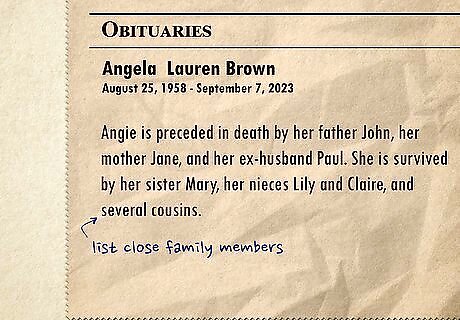
List close family members in the third paragraph. Mention close family members, such as immediate family and parents, by name. When you want to list extended family, use a collective phrase (i.e., several, many, etc.) or list the specific number. For others that have passed away before your loved one, use the phrase “preceded in death by.” Use “survived by” before listing any relatives still living. There are no set rules about who should be included. Use your best judgment to determine who was most important to your loved one and are worth mentioning. For example: “John is preceded in death by his father, Tom, and his mother, Jill. He is survived by his wife, Jane, his 2 children, Anna and Benjamin, and several cousins, nieces, and nephews.” “Angie is preceded in death by her father John, her mother Jane, and her ex-husband Paul. She is survived by her sister Mary, her nieces Lily and Claire, and several cousins.” “Joseph is preceded in death by his father Harry and is survived by his mother Linda, his brother Tom, his sister Lucy, his wife Sarah, and many aunts, uncles, cousins, nieces, and nephews.”

Provide details about the funeral service if it’s public. If you’re holding a public service, list the time and date along with the name of the funeral home. Make sure to list the specific details so others who were close to your loved one know where to go. If you’re holding a separate visitation, reception, and/or graveside service, include the details for each event. For example: “A public memorial service will be held at 11:30 AM on June 11th, 2019 at the Church of Christ.” “A public visitation will be held from 2 PM to 6 PM on May 20th, 2022 at Eastside Funeral Home. A separate graveside service will take place on May 21st at 10 AM at Rolling Hill Cemetery.” You do not have to provide any information if there is no public service. Include information about the location for sending in flowers for a memorial or where people can make donations.Tip: If you would rather have monetary donations at the service rather than flowers at the funeral, include a statement that says, “In lieu of flowers…” followed by the donation location.
Revising

Read the obituary out loud to catch any errors. Carefully read the obituary after you’ve written it to check the grammar and look for spelling errors. Note your changes with a pen or pencil so you know to go back and change them. If you wrote your paper on a computer, print it out so you can easily mark up the page with what you need to change.

Ask a friend or family member to check for missed information. Give the obituary you’ve written to a close relative so they can see if they have anything to add or would like to remove. Write down any suggestions they have and try to work them into a new copy of the obituary. Talk to multiple people that were close to your loved one to see if they have any stories or details they think should be included.

Compare your obituary to other obituaries in the paper. Read through the current obituaries for the paper you’re planning on submitting yours to. Many newspapers have a certain style they want all of their obituaries written, so make sure yours follows whatever format they use. If you’re looking to submit to more than one newspaper, you might have to write multiple versions of your obituary to fit each newspaper’s standards. If your obituary strays too far from a newspaper’s standards, they might rewrite it. This could lead to errors being accidentally written in, so do your best to make your version as close to their format as possible. Obituaries don’t need to look exactly the same, but they should contain all the important information necessary.
Submitting
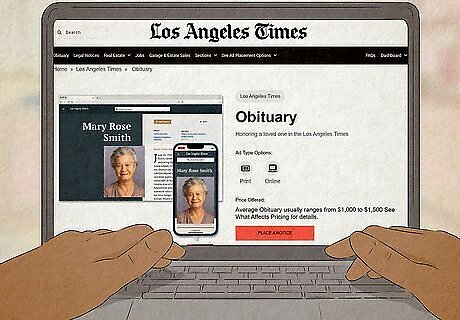
Look on your local paper’s website to see how to submit an obituary. Many papers accept obituaries through a web portal or by email. Look up the website for your local paper to see how they accept their submissions and what files you need to include. Plan on submitting the obituary 2-3 days before the service is held so others can make travel arrangements to get there. Look into their pricing for printing as well. Most newspapers charge you based on how many inches your tribute takes up on the physical paper. These can get pretty pricey, so set a budget for yourself.Tip: Many funeral packages offer obituaries with their services. If you’re using one, check with the package you have to see when you need to submit the obituary through them.
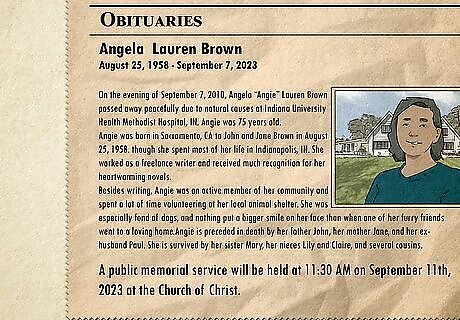
Provide a photo of the deceased if you would like. Choose a happy photo of your loved one so other people recognize that they lived a good life. Check with the newspaper where you plan on submitting to see if they have any size requirements for the photo you plan on submitting. Some newspapers charge an additional fee to publish pictures. Check with the paper’s obituary requirements to see.

Submit your obituary before the print deadline if you want it in the paper. Many newspapers have a print deadline of about 2 or 3 PM. Check with the paper you’re submitting so you know the exact deadline for when you need the obituary finished. Even if you don’t make the print deadline, the obituary will still be published on the newspaper’s website.



















Comments
0 comment